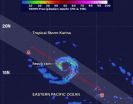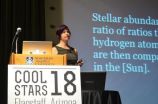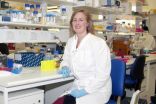(Press-News.org) Edmonton—The invention of fibre optics revolutionized the way we share information, allowing us to transmit data at volumes and speeds we'd only previously dreamed of.
Now, electrical engineering researchers at the University of Alberta in Edmonton, Alberta, Canada are breaking another barrier, designing nano-optical cables small enough to replace the copper wiring on computer chips.
This could result in radical increases in computing speeds and reduced energy use by electronic devices.
"We're already transmitting data from continent to continent using fibre optics, but the killer application is using this inside chips for interconnects—that is the Holy Grail," says Zubin Jacob, an electrical engineering professor leading the research. "What we've done is come up with a fundamentally new way of confining light to the nano scale."
At present, the diameter of fibre optic cables is limited to about 1/1000th of a millimetre. Cables designed by graduate student Saman Jahani and Jacob are 10 times smaller—small enough to replace copper wiring still used on computer chips. (Put into perspective, a dime is about 1 mm thick.)
Jahani and Jacob have invented a new, non-metallic metamaterial that enables them to "compress" and contain light waves in smaller cables without creating heat, slowing the signal or losing data. Their findings will be published in Optica (Aug. 20), The Optical Society's (OSA) new high-impact photonics journal. The article is available online.
INFORMATION:
The team's research is funded by the Natural Sciences and Engineering Research Council of Canada and the Helmholtz-Alberta Initiative.
For further information and to arrange interviews contact:
Richard Cairney
Communications Officer
University of Alberta Faculty of Engineering
780.492.4514
780.886.9278 (mobile)
richard.cairney@ualberta.ca
Electrical engineers take major step toward optical computing
Team invents non-metallic metamaterial that enables them to 'compress' and contain light
2014-08-19
ELSE PRESS RELEASES FROM THIS DATE:
NASA sees Tropical Storm Karina losing its punch
2014-08-19
Tropical Storm Karina continues to weaken in the Eastern Pacific over open waters, and NASA data shows there's not much punch left in the storm.
NASA's Tropical Rainfall Measuring Mission or TRMM satellite can measure the rate of rainfall from its orbit in space and when it passed over Tropical Storm Karina in the Eastern Pacific it saw an isolated area of heavy rain remaining in the storm.
Tropical Storm Karina weakened during the overnight hours and by Tuesday, August 19, maximum sustained winds had decreased to near 60 mph (95 kph). When TRMM passed overhead at 03:04 ...
Secrets of how worms wriggle uncovered
2014-08-19
LIVERPOOL, UK – 19 August 2014: An engineer at the University of Liverpool has found how worms move around, despite not having a brain to communicate with the body.
Dr Paolo Paoletti, alongside his colleague at Harvard, Professor L Mahadevan, has developed a mathematical model for earthworms and insect larvae which challenges the traditional view of how these soft bodied animals get around.
The most widely accepted model is that of the central pattern generator (CPG) which states that the central brain of these creatures generates rhythmic contraction and extension ...
NASA sees Depression 12-E become Tropical Storm Lowell
2014-08-19
In less than 24 hours after Tropical Depression 12-E was born in the eastern Pacific Ocean it strengthened into Tropical Storm Lowell. NOAA's GOES-West and NASA's Aqua satellite captured infrared images of the massive storm as it continues to strengthen.
On August 18 at 21:11 UTC (5:11 p.m. EDT), NASA's Aqua satellite passed over the Eastern Pacific and the Atmospheric Infrared Sounder (AIRS) instrument gathered infrared data on Lowell's clouds and sea surface temperatures. The AIRS infrared data showed that powerful thunderstorms stretching high into the troposphere ...
Hand gestures improve learning in both signers and speakers
2014-08-19
Spontaneous gesture can help children learn, whether they use a spoken language or sign language, according to a new report.
Previous research by Susan Goldin-Meadow, the Beardsley Ruml Distinguished Service Professor in the Department of Psychology, has found that gesture helps children develop their language, learning and cognitive skills. As one of the nation's leading authorities on language learning and gesture, she has also studied how using gesture helps older children improve their mathematical skills.
Goldin-Meadow's new study examines how gesturing contributes ...
Solar salad, anyone?
2014-08-19
TEMPE, Ariz. – An Arizona State University alumna has devised the largest catalog ever produced for stellar compositions. Called the Hypatia Catalog, after one of the first female astronomers who lived ~350 AD in Alexandria, the work is critical to understanding the properties of stars, how they form, and possible connections with orbiting planets. And what she found from her work is that the compositions of nearby stars aren't as uniform as once thought.
Since it is not possible to physically sample a star to determine its composition, astronomers study of the light ...
Leukemia drug shows promise for skin, breast and other cancers
2014-08-19
MAYWOOD, Ill -- A leukemia drug called dasatinib shows promise for treating skin, breast and several other cancers, according to researchers at Loyola University Chicago Stritch School of Medicine.
Dasatinib fights leukemia by checking the uncontrolled growth of cancer cells. But when used against other cancer cells, researchers found, the drug employs a different strategy: It causes the cells to clump together, thus preventing them from migrating. Without the ability to migrate, cancer cells cannot metastasize (spread to other parts of the body).
Mitchell Denning, ...
Electroacupuncture attenuates neuropathic pain after brachial plexus injury
2014-08-19
Electroacupuncture has traditionally been used to treat pain, but its effect on pain following brachial plexus injury is still unknown. In a recent study reported on the Neural Regeneration Research (Vol. 9, No. 14, 2014), rat models of an avulsion injury to the left brachial plexus root (associated with upper-limb chronic neuropathic pain) were given electroacupuncture stimulation at bilateral Quchi (LI11), Hegu (LI04), Zusanli (ST36) and Yanglingquan (GB34). After electroacupuncture therapy, chronic neuropathic pain in the rats' upper limbs was significantly attenuated. ...
Genetic key to lupus shows potential of personalized medicine
2014-08-19
Medical researchers have used DNA sequencing to identify a gene variant responsible for causing lupus in a young patient.
The development shows that for the first time, it is feasible for researchers to identify the individual causes of lupus in patients by using DNA sequencing, allowing doctors to target specific treatments to individual patients.
Lupus is a chronic autoimmune disease that affects one in 700 Australians, predominantly young and middle aged women.
Medical researchers at the Australian National University's Centre for Personalised Immunology, based ...
MIPT and RAS scientists made an important step towards creating medical nanorobots
2014-08-19
Researchers from the Institute of General Physics of the Russian Academy of Sciences, the Institute of Bioorganic Chemistry of the Russian Academy of Sciences and MIPT have made an important step towards creating medical nanorobots. They discovered a way of enabling nano- and microparticles to produce logical calculations using a variety of biochemical reactions.
Details of their research project are given in the journal Nature Nanotechnology. It is the first experimental publication by an exclusively Russian team in one of the most cited scientific magazines in many ...
Opioid users breathe easier with novel drug to treat respiratory depression
2014-08-19
Chicago – August 19, 2014 – People taking prescription opioids to treat moderate to severe pain may be able to breathe a little easier, literally. A study published in the September issue of Anesthesiology, the official medical journal of the American Society of Anesthesiologists® (ASA®), found that a new therapeutic drug, GAL-021, may reverse or prevent respiratory depression, or inadequate breathing, in patients taking opioid medication without compromising pain relief or increasing sedation.
"Although opioids such as oxycodone, methadone and fentanyl are commonly ...
LAST 30 PRESS RELEASES:
Making lighter work of calculating fluid and heat flow
Normalizing blood sugar can halve heart attack risk
Lowering blood sugar cuts heart attack risk in people with prediabetes
Study links genetic variants to risk of blinding eye disease in premature infants
Non-opioid ‘pain sponge’ therapy halts cartilage degeneration and relieves chronic pain
AI can pick up cultural values by mimicking how kids learn
China’s ecological redlines offer fast track to 30 x 30 global conservation goal
Invisible indoor threats: emerging household contaminants and their growing risks to human health
Adding antibody treatment to chemo boosts outcomes for children with rare cancer
Germline pathogenic variants among women without a history of breast cancer
Tanning beds triple melanoma risk, potentially causing broad DNA damage
Unique bond identified as key to viral infection speed
Indoor tanning makes youthful skin much older on a genetic level
Mouse model sheds new light on the causes and potential solutions to human GI problems linked to muscular dystrophy
The Journal of Nuclear Medicine ahead-of-print tip sheet: December 12, 2025
Smarter tools for peering into the microscopic world
Applications open for funding to conduct research in the Kinsey Institute archives
Global measure underestimates the severity of food insecurity
Child survivors of critical illness are missing out on timely follow up care
Risk-based vs annual breast cancer screening / the WISDOM randomized clinical trial
University of Toronto launches Electric Vehicle Innovation Ontario to accelerate advanced EV technologies and build Canada’s innovation advantage
Early relapse predicts poor outcomes in aggressive blood cancer
American College of Lifestyle Medicine applauds two CMS models aligned with lifestyle medicine practice and reimbursement
Clinical trial finds cannabis use not a barrier to quitting nicotine vaping
Supplemental nutrition assistance program policies and food insecurity
Switching immune cells to “night mode” could limit damage after a heart attack, study suggests
URI-based Global RIghts Project report spotlights continued troubling trends in worldwide inhumane treatment
Neutrophils are less aggressive at night, explaining why nighttime heart attacks cause less damage than daytime events
Menopausal hormone therapy may not pose breast cancer risk for women with BRCA mutations
Mobile health tool may improve quality of life for adolescent and young adult breast cancer survivors
[Press-News.org] Electrical engineers take major step toward optical computingTeam invents non-metallic metamaterial that enables them to 'compress' and contain light






